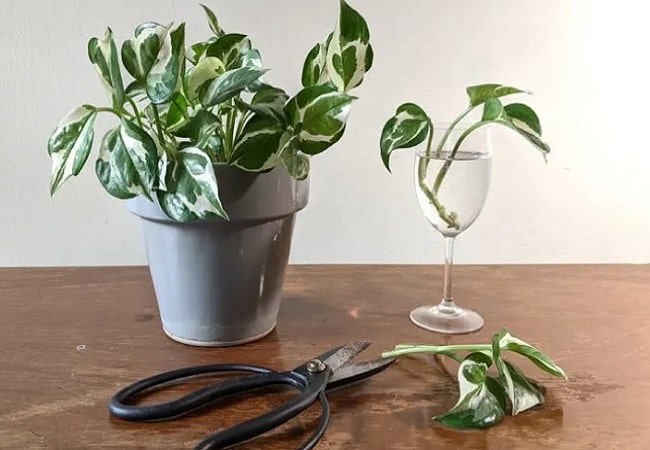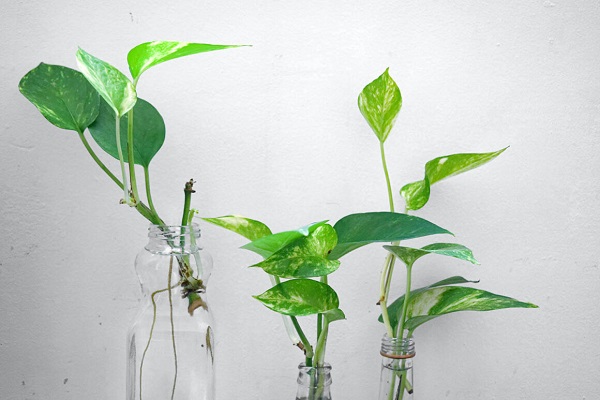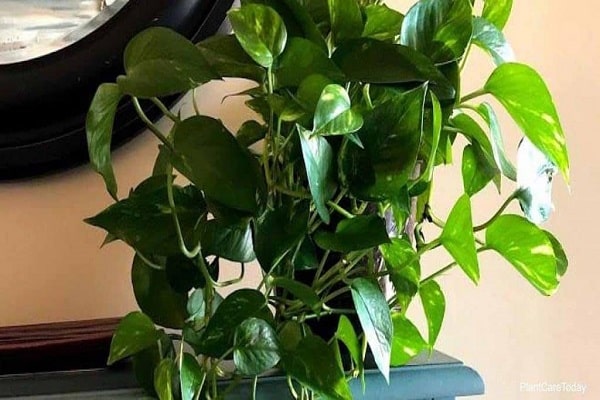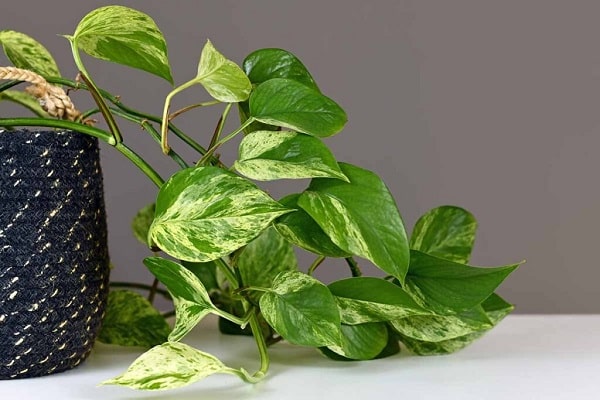If you’re looking for an easy and low-maintenance way to grow new houseplants, propagating pothos in the dirt is a great option. Pothos is a popular indoor plant known for its long, trailing vines and heart-shaped leaves. The plant’s capacity to thrive in a variety of settings makes it a good choice for novice and professional gardeners alike.
By propagating pothos in the dirt, you can create new plants from cuttings and expand your collection without spending much money. In this guide, we’ll walk you through how to propagate pothos in dirt so that you can grow your own healthy and beautiful plants.
Quick Navigation
How To Propagate Pothos In Dirt

Growing new pothos plants from seed requires little more than soil, a few tools, and some time. Instructions for planting and growing pothos in soil are provided below.
Gather Materials
- Pothos plant
- Pruning shears
- Potting soil
- Pots or containers
- Watering can or spray bottle
Take Cuttings
- Select a healthy pothos plant and choose a stem at least 4-6 inches long.
- Cut the branch right below a node (the point where a leaf joins to the stem) using clean, sharp pruning scissors.
- Cut at a 45-degree angle to increase the surface area for rooting.
Prepare Soil
- Fill a container with well-draining potting soil.
- Make a hole in the soil with your finger or a pencil, about 1-2 inches deep.
Plant Cuttings
- Rooting hormones can be used on the stem’s cut end.
- Gently place the cutting into the hole in the soil, ensuring the node is buried in the soil.
- To keep the stem in place, push the earth firmly round it.
Monitor Growth
- Water the soil thoroughly but avoid overwatering, as this can lead to root rot.
- Keep the container in a warm, well-lit spot; however, direct sunlight should be avoided to prevent leaf burn.
- Monitor the growth of your pothos cutting, checking the soil moisture level and adding water as needed.
- After a few weeks, you should see new growth that confirms the cutting was successful.
Following these steps, you can easily propagate your pothos plant in dirt and enjoy a new plant for your home or garden.
Choosing a Propagation Method

Plant propagation refers to the process of creating new plants from existing ones. Several methods for propagating plants include seed propagation, cutting propagation, division propagation, layering propagation, and grafting propagation. There are some plants that are more suited to some methods than others, and each technique has its own advantages and limitations.
When choosing a propagation method, it’s essential to consider factors such as the type of plant, the time of year, the level of difficulty, and the resources needed for each method. By selecting the best method for your plant and situation, you can increase your chances of success and enjoy the rewards of growing new plants from scratch. There are some plants that are more suited to some methods than others, and each technique has its own advantages and limitations.
When to Propagate Pothos

Pothos is a popular and easy-to-grow houseplant that can be propagated in various ways, including stem cuttings, division, and layering. There are some plants that are more suited to some methods than others, and each technique has its own advantages and limitations. Here are some guidelines for propagating pothos:
Stem Cuttings
Take stem cuttings at least 4-6 inches long and have several leaves. Remove the lowest leaves, leaving only a few, by cutting just below a node (the point where a leaf joins to the stem). Keep the cutting in a warm, sunny place with water or moist soil in a container. In a few weeks, the cutting will have established roots and can be transferred to a larger container.
Division
Your pothos can be divided into several new plants if it has outgrown its existing container. With caution, remove the plant from its container and separate the root ball, making that each division contains a sufficient number of stems and roots. Replant the sections into their own pots with fresh soil.
Layering
When propagating pothos, you can also use the layering method, which entails bending a stem to the ground and covering it with a thin layer of dirt or moss. Don’t cover up the stem’s very end. Water the soil regularly; roots will soon begin to develop at the buried portion of the stem. Once new roots have formed, remove the old soil and repot the plant. Remember to keep your pothos cuttings or divisions in a warm, bright location with consistent moisture while they establish their roots.
How to Propagate Pothos in Water

Stem cuttings are one of the simplest ways to propagate pothos in water. How to make a pothos plant multiply in water:
Choose a healthy pothos plant and select a stem at least 4-6 inches long with several leaves. Remove the lower leaves off the stem by cutting slightly below a node.
- Remove the leaves from the stem’s bottom 2-3 inches, leaving only a few leaves at the top.
- Place the cutting in a clean jar or vase filled with fresh water, ensuring that the bottom 2-3 inches of the stem are submerged.
- Keep the jar in the sunlight for as long as possible.
- Moreover, you should avoid stagnant water by changing the water every few days.
- Wait for the cutting to develop roots, which should take several weeks. Once the roots are 1-2 inches long, the cutting can be planted in the soil.
- Carefully drain the water from the cutting and place it in a container with potting soil. Place the plant in indirect sunlight and keep the soil moist but not soggy.
- Continue caring for the newly propagated plant as you would a mature pothos plant, watering it regularly and providing enough sunlight.
Remember that not all cuttings will root successfully, so taking several cuttings is an excellent idea to increase your chances of success. Additionally, it’s essential to keep the water clean and free of bacteria to prevent the cutting from rotting.
FAQs
How Long Does It Take Pothos To Root In Dirt?
Pothos cuttings typically take around 2-4 weeks to root in soil, depending on the cutting’s environmental conditions and health. It’s important to be patient during the rooting process, as the cutting can take some time to establish a root system.
Can You Put Cuttings Straight Into The Soil?
You can put pothos cuttings straight into the soil without rooting them in water first. Choose a potting soil with good drainage, and water moderately yet regularly. A rooting hormone can also speed up the process of the cutting taking root.
How Do You Propagate Pothos Stems In Soil?
propagate pothos stems in soil, start by selecting a healthy stem and cutting it just below a node. Rooting hormone (not required) is applied to the cut end of the stem before it is planted in potting soil with good drainage. Keep the cutting in a warm, bright area out of direct sunlight and water the soil generously.
Does Pothos Root Faster In Water Or Soil?
Pothos can root in both water and soil, but generally, they tend to root faster in water. However, once the cutting has developed roots, it’s essential to transfer it to soil to allow it to establish a stronger root system and continue growing.
Why Are My Pothos Cuttings Not Rooting In The Soil?
There could be several reasons why pothos cuttings are not rooting in the soil. Over or under-irrigating, poor soil excellence, planting the cutting too deeply, or the need for additional heat and humidity could all be to blame.
Use well-draining soil, water it when it is slightly dry, and keep the cutting in a warm and humid environment to encourage rooting. It’s also important to be patient, as the cutting can take several weeks to establish roots.
Conclusion
Propagating pothos in the dirt is a simple process that can be done by following a few easy steps. First, take a healthy pothos plant and cut a stem with a few leaves. Once the lower leaves have been removed, the stem can be dipped into a rooting hormone powder and the cut end replanted. Then, bury the snipped end of the stem at least an inch into a pot of nutrient-rich, well-drained soil. Take care to maintain moist soil and position the container in indirect sunlight.

My name is Md Deloar Hossain and I’m the creator of Club Gardening, designed for all your gardening ideas, gardening product reviews, and a place to help you find the best gardening experience possible.


